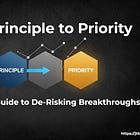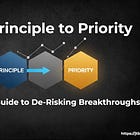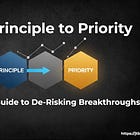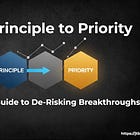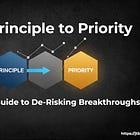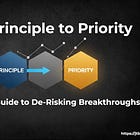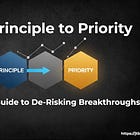From Principle to Priority: Chapter 9
The 10 Types: Designing the “Business Model” Around the “Solution”
This 10-article series is designed to disrupt common thinking about innovation. It provides a new framework to help you tear down old methods and invest more efficiently in breakthrough ideas. Please share!
We have come a long way. We have successfully de-risked the two most significant and common failure points in innovation.
First, we de-risked the problem. Our journey through First Principles and qualitative JTBD (Stage 1) and our quantitative Heatmap (Stage 2) ensured we are not building a solution in search of a problem. We have a data-driven, rank-ordered list of validated, underserved needs. We are not guessing what matters; we know.
Second, we de-risked the solution. Our Minimum Viable Prototype (MVPr) in Stage 3 (Chapter 8) proved that our proposed solution mechanic can deliver a 10x outcome. By manually performing the job as a “concierge” service for our target CFOs, our tiger team proved that a process focused on Locate, Prepare, and Resolve delivers the “zero-error, auditable data asset” that our customers crave. We have a validated process before writing a single line of production code.
This is where most teams declare victory. They have a validated problem and a proven solution. They take this to the investment committee, get their $5 million to build the factory, and launch the product. And yet, many still fail.
They fail because they have overlooked the third, silent, and most insidious risk: Business Model Risk.
A brilliant product, wrapped in a broken business model, will fail every single time. A me-too profit model, a flimsy channel strategy, or a non-existent brand can doom a 10x solution.
The team’s failure of imagination is to assume their work is done. They see innovation as being only about “Product Performance.” This is where we introduce our final strategic lens, a framework designed to force a holistic, 360-degree view of the entire business: The 10 Types of Innovation.
This framework, developed by the firm Doblin, is a powerful antidote to this tunnel vision. It’s a diagnostic tool that proves breakthrough innovations are rarely just one thing. They are almost always a combination of reinforcing moves.
The 10 Types are grouped into three categories:
CONFIGURATION (The Business Model): The “back-end” of the business. How you make money and organize.
Profit Model: How you make money.
Network: How you connect with others to create value.
Structure: How you align your talent and assets.
Process: Your signature methods for doing your work.
OFFERING (The Product): The “core” of what you sell.
Product Performance: The distinguishing features and quality of your core solution.
Product System: The ecosystem of supporting products and services.
EXPERIENCE (The Customer Interface): The “front-end” of the business. How you interact with your customers.
Service: How you support and amplify the value of your offering.
Channel: How you deliver your offering to customers.
Brand: How you represent your offering and business.
Customer Engagement: How you foster distinctive interactions.
Most companies compete—and fail—on “Product Performance” alone. They try to out-feature their competitors, a race to the bottom that is expensive and exhausting.
True, defensible, “category-of-one” businesses are built by innovating across multiple types, often in the “unsexy” Configuration and Experience categories. This is how you build a moat.
Let’s apply this to our CFO solution.
We already have Type 5: Product Performance. It’s our validated “Locate, Prepare, Resolve” mechanic that creates a zero-error, auditable data asset. This is our anchor. Now, let’s build the fortress around it.
1. Profit Model (Configuration)
The Obvious (and Wrong) Move: A standard, per-seat, monthly SaaS license. (e.g., “$5,000/month for 10 users”). This is boring, easy to copy, and forces the CFO to do a line-item budget comparison against a competitor’s (inferior) product that costs $4,000/month. It commoditizes our 10x solution.
The 10x Move (Value-Based): We must align our price with the value we create. What value did our MVPr deliver?
“Audit Guarantee” Model: We sell our solution as an insurance policy. For a flat annual fee, we guarantee a “zero-error” audit. We are selling certainty and risk reduction, which is what a CFO actually buys. This speaks their language.
“Per-Error-Resolved” Model: What if the core software is free, but we charge a premium for every critical error we find and fix? This is a “pay-for-performance” model that is incredibly confident.
“Liability-Remediated” Model: What if we charge a percentage of the value of the offsets or liabilities we manage? This directly ties our revenue to the scale of our client’s success.
2. Network (Configuration)
The Obvious Move: Go it alone. Try to out-market everyone.
The 10x Move (Partnership): Who else in the ecosystem needs our solution? The “Big 4” accounting firms. They are the ones conducting these audits.
We create a “Partner Program” and make our tool the official platform for environmental liability auditing. We make them look smarter and more efficient. They become our channel (Type 8) and our network (Type 2). They bring us clients, and we give them the tool to serve them.
6. Product System (Offering)
The Obvious Move: Build an all-in-one, monolithic platform that does all 9 steps of the Job Map. (And does 6 of them poorly).
The 10x Move (The “Missing Link”): We don’t replace the “calculators” (Step 4) or the “reporting tools” (Step 6). We become the indispensable “data-wrangling” engine that feeds them.
We create a “System” where our “auditable data asset” is the input. We build robust APIs that plug into the existing, popular carbon calculators and reporting platforms. We make their products better, becoming the “Intel Inside” of the entire carbon ecosystem.
7. Service (Experience)
The Obvious Move: A standard “Help” menu and a Zendesk chatbot.
The 10x Move (White-Glove Onboarding): What was the magic of our MVPr? It was the concierge service.
We institutionalize this. For the first 30 days, every new client gets access to a “Data Forensics” tiger team (our Structure, Type 3) who manually onboards them, maps their disparate data sources, and proves the value, just like the MVPr. This premium service overcomes the #1 hurdle (implementation friction) and locks them in.
9. Brand (Experience)
The Obvious Move: A green-and-blue logo with a leaf. A brand built around “sustainability” and “saving the planet.”
The 10x Move (Financial-Grade Certainty): This brand is wrong. We are not selling to the sustainability manager; we are selling to the CFO.
Our brand must be one of trust, certainty, and financial-grade audibility. Our logo should look more like a bank or an auditor than a tech startup. Our language must be about risk reduction, error elimination, and balance sheet protection. We are selling boring, reliable, unassailable truth.
10. Customer Engagement (Experience)
The Obvious Move: A monthly email newsletter.
The 10x Move (The Value-Proof Report): What was the most powerful deliverable from our MVPr? The “Summary of Findings”—the one-page report that showed the 15 errors our team found.
We automate this. We turn it into a “Quarterly Risk-Reduction Report” that is auto-generated and emailed to the CFO. It’s a simple dashboard that says: “This quarter, our platform automatically located 1,200 data points, standardized 8 systems, and caught 43 critical errors that would have put your audit at risk.”
This isn’t an engagement gimmick. It is a churn-killing machine. It perpetually re-proves the product’s value, making it impossible to rip out.
Look at what we’ve done.
We started with a single “Product Performance” idea. By applying the 10 Types, we have now designed a business.
It’s a “Tech-Enabled Service” (Structure + Service) that sells “Financial-Grade Certainty” (Brand), using an “Audit Guarantee” (Profit Model). It is delivered via “Accounting Firm Partners” (Network + Channel) and locks in value with an “API-driven Ecosystem” (Product System) and a “Quarterly Risk-Reduction Report” (Customer Engagement).
This is a fortress. This is a defensible, multi-moated business.
We are now, finally, ready to write the monolithic business case. But it’s no longer a document of fiction, guesses, and fabricated 5-year ROIs.
It is a summary of validated facts.
It will tell the story of our journey: Here is the $100B problem we deconstructed from First Principles. Here is the precise, 9-step Job-to-be-Done we discovered. Here is the quantitative heatmap, proving with data where the real underserved needs are. Here is the case study from our manual prototype, proving our solution mechanic works. And here is our 10-Type business design, showing how this one product becomes a category-defining, defensible business.
We have moved from a high-stakes gamble to a staged, de-risked, strategic investment. We have paid our small premiums for the Option to Explore and the Option to Validate.
Now, with all uncertainty systematically eliminated, we are making one final, confident, and fully-informed recommendation: to fund the Option to Scale.
Guide to the Series



